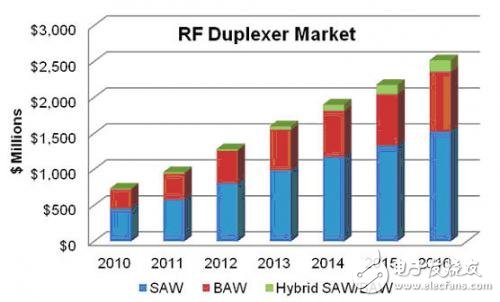The new high-performance acoustic wave filter of technology-leading RF solution leader TriQuint Semiconductor has been adopted in the design of popular 4G smartphones such as Samsung, LG, HTC and Motorola Mobile. These new filters, currently in volume shipment, use TriQuint's extensive technology portfolio to provide the outstanding filtering performance required for the most challenging LTE bands.
LTE deployment has driven the demand for high-performance filters in today's multi-band smartphones. High-end smartphones have more and more cellular and Wi-Fi bands to support 2G / 3G / 4G voice and data services and global roaming. In addition, the shortage of global spectrum resources has led governments around the world to squeeze 4G wireless services into new frequency bands around the existing frequency bands and use the least guard bands. Therefore, advanced filtering techniques are needed to mitigate the resulting interference problems.
"Our customers rely on TriQuint to solve their most difficult filtering challenges," said Xiong Ting, general manager of TriQuint Semiconductor China. "Thanks to three decades of innovation in filtering technology and our extensive manufacturing expertise, we are already working on sound wave technology. Significant progress has been made in the field. We are one of the very few high-volume suppliers that can meet the stringent performance requirements for the most stringent LTE filter bands. In the next few years, the deployment of next-generation LTE Advanced upgraded networks will further drive more TriQuint high-performance filters are required to obtain the benefits of carrier aggregation (carrier aggregaTIon). "
Filters, duplexers and switch products have accounted for nearly half of the $ 6.4 billion RF market. As LTE networks continue to be deployed, passive devices in smartphones, tablets and other mobile devices will continue to grow. "With our technological leadership, unparalleled integration expertise, chipset reference design and continuous capacity investment, TriQuint is well positioned in this important market segment to win more business," Xiong Ting said. TriQuint increased manufacturing capacity by 40% in 2011 to support customer demand for its growing mobile device product portfolio.
Explosive demand for smartphone filters

Driven by the growth of WCDMA and the deployment of LTE networks, the market for RF duplexers for cellular terminals will reach US $ 2.5 billion in 2016. (Source: Navian Inc.)
"The RF duplexer market alone will reach US $ 2.5 billion in 2016," said Yoshiyasu Andoh, president of Navian Market Research. "The widespread use of WCDMA and the increasing number of LTE bands are driving the duplexer at a rapid rate. Product requirements. With the increase in RF complexity, we are expected to see further integration of passive components such as filters and duplexers with active components such as power amplifiers and switches.
High-performance 4G filtering
With the deployment of LTE networks and the popularization of Wi-Fi, the demand for high-performance filters has shown a surge. The new 4G frequency band is usually close to the existing frequency band for Wi-Fi and Bluetooth services, and the guard band is very small. TriQuint's Bulk Acoustic Wave (BAW) and Temperature Compensation (TC-SAW) technologies help 4G smartphones operating in many different frequency bands in multiple regions of the world, while enabling voice and data services. Since 2006, TriQuint ’s SAW filter shipments have exceeded 2 billion, and BAW filter shipments have approached 1 billion.
In addition to mobile devices, TriQuint ’s innovations in SAW, TC-SAW, and BAW devices have become the foundation of the world ’s most advanced communication systems through R & D cooperation with partners such as the US Department of Defense ’s Advanced Research Projects Agency (DARPA). TriQuint is the only high-volume RF supplier that provides all three filters, either as stand-alone devices or integrated modules. By integrating active and passive components into miniature modules, TriQuint uses innovative technologies such as CuFlip and its new wafer-level packaging (WLP) process to provide size, cost, and performance advantages.
TC-SAW and BAW: support 4G smart phones
SAW filters are ideal for most frequencies that pass 1.9 GHz, such as the standard GSM, CDMA, and 3G bands. Some new 3G and 4G WCDMA duplexers and filters are most beneficial to TC-SAW, reducing temperature drift for more challenging specifications. For example, TriQuint uses TC-SAW to support duplexers for band 13, band 20, and band 26.
BAW is well-suited for many new LTE bands above 1.9 GHz and provides excellent performance with lower insertion loss, steeper slope curves and excellent suppression. BAW performs well in applications where the uplink and downlink frequency separation is minimal and when attenuation is required in tightly packed adjacent frequency bands. TriQuint takes advantage of BAW technology to support the following frequency bands: Band 3, Band 7, Band 25, Band 38, Band 40, Band 41, and Wi-Fi coexistence filter.
Parabolic Reflex Reflector,Parabolic Grow Reflector,Aluminum Lamp Reflector,Safety Lighting Covers
Yangzhou Huadong Can Illuminations Mould Manufactory Co., Ltd. , https://www.light-reflectors.com